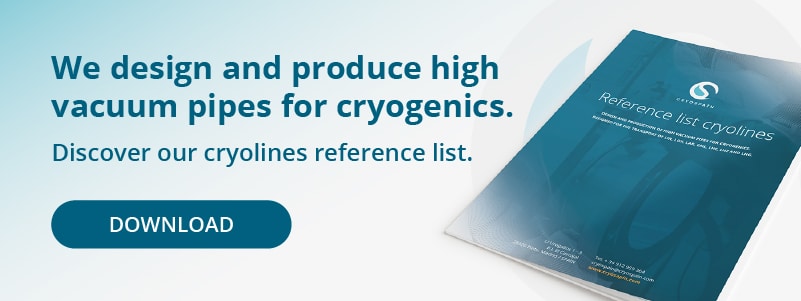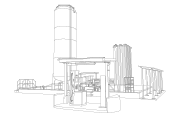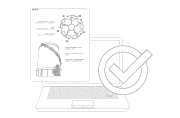Cryogenic piping is an essential element for many industries in need for a safe and efficient transportation of cryogenics. At Cryospain, we’ve devised our Cryoline system that provides secure super-insulated, high vacuum pipes for the transportation of a wide range of cryogenic liquids, including LIN, LOX, LAR, LNG, LHe, and LH2.
Through our decades-long expertise in cryogenic piping, we’ve been able to develop Cryoline, a vacuum jacketed piping which stands as an optimal solution against the entry of heat and gasification due to environmental factors during transfer between cold points.
Keep reading to find out how our Cryoline systems help companies preserve and transport cryogenics.
What is Cryoline used for?
A wide range of industrial sectors are in need for safe and efficient transportation of cryogenic liquids. These range from the production of liquid gases or bunkering of LNG to cryobiology, aerospace, food, and transport companies. High vacuum pipes such as our Cryoline models have long been regarded as the best option in order to do so.
Systems such as Cryoline must ensure that extreme cold is preserved. At the same time, energy loss can become a huge issue during the transportation of cryogenic liquids, which may lead to a lack of efficiency and productivity. To avoid this, the installation of high-quality vacuum jacketed piping guarantees that cryogenic liquids are transported safely and efficiently.
Cryogenic piping is also increasingly demanded by the shipping industry, in light of a growing demand for converting ships into LNG-powered vessels. As new regulations (such as IMO 2020) seek to control sulphur content in fuel oil used by ships, maritime companies opt to convert their engine systems to LNG, which present advantages from both a sustainability and cost-efficiency point of view. Our Cryoline systems assist companies through their conversion projects.
Most common transported gases
Cryogenic piping is at the heart of a safe and optimized transportation of a number of gases that are essential for many industries today.
Cryogenic gases are cooled to liquid form because, as they pressure descends, they are manipulated (transported, stored…) more easily. They are odourless, colourless, non-toxic and non-corrosive substances and the main hazards associated with them are flammability after vaporisation, freezing and asphyxiation by inhalation.
As many technical gases require very low temperatures (around -150°C), these gases and the required installations face a number of unique challenges. Systems such as Cryoline help companies overcome these challenges.
The most common cryogenic gases used today across a number of sectors and that require vacuum jacketed piping include:
1. LNG: Liquefied Natural Gas
Liquefied Natural Gas is natural gas that has undergone a liquefaction process through specialized refrigeration cycles in tankers for safe and economical transport and storage. It contains 95% methane, which is considered the cleanest fossil fuel among other alternatives.
Typically sourced from countries such as Algeria, Norway, Qatar, Russia, Nigeria and the United States, this gas presents a wide range of uses in industrial sectors, transportation and household applications. The transportation for LNG must be done through a cryogenic pipe such as Cryoline.
2. LIN: Liquid Nitrogen
Liquid nitrogen is odourless, colourless, non-toxic, non-flammable and relatively inert, while presenting a slightly lighter texture than air at room temperature. Today, it plays an important role in different processes, including the freezing and transporting of food, the cryopreservation of biological samples, refrigeration for superconductors, and cryotherapy treatments for skin.
In order to use it, liquid nitrogen is stored in special containers, vented to prevent pressure build-up, and transported through high vacuum pipes.
3. LOX: Liquid Oxygen
Liquid oxygen is another of the most common gases that is liquefied for a more efficient transportation through cryogenic piping and storage in cryogenic storage tanks. It presents a high oxidising power, although it is not flammable, and is used as an oxidant for liquid fuels (such as those used in missiles and rockets) and the metal industries, among others.
4. LAR: Liquid Argon
Argon is a noble gas that helps prevent welded metals from rusting. At the same time, it’s widely used in health care treatments, lighting and the food industry, among others.
5. LCO2: Liquid Carbon Dioxide
Liquid carbon dioxide is an indispensable element in the food, electronics and the chemical industries.
Related content: Pipe in pipe: the system that adapts to your changing needs
Discover each part of Cryoline, our cryogenic pipes
The safe and efficient transportation of gases directs companies to the use of high vacuum pipes such as a pipe in pipe system. This model of cryogenics transportation consists of a generic term embracing all types of tubes that present two walls or barriers. These walls can be metallic, plastic or made of fibres and the content between each barrier can also be varied, although it usually consists of an insulating material.
Vacuum jacketed piping is thus the most efficient solution for cryogenic piping or cold piping and it usually consists of the following parts:
- Inner pipe: in direct contact with cryogenics, it endures colder temperatures and shrinks, so that compensators must be included.
- Outer pipe.
- A space between the two pipes, which is vacuumized.
- Spacers, which are systems to prevent the two pipes from touching each other. They are in charge of absorbing the potential stress produced by the shrinkage of the inner pipe.
Through this double-wall system, the model ensures cold liquid gases are safely and efficiently transported.
Keep reading: Pipe in Pipe: the ideal cryogenic pipes for bunkering plants
Cryoline: a system that crystallizes Cryospain’s expertise
Cryospain provides cryogenic engineering adapted to each project’s needs, generating high technology for low temperatures. Through our Cryoline systems, we ensure companies have access to secure and cost-efficient cryogenic piping in order to meet their needs.
Through various projects, Cryospain has designed, manufactured, and installed over 10000 meters of vacuum-insulated pipe for the transportation of different types of gas:
> 60 LIN / LOX / LAR projects
> 25 LNG projects
> 7 LHe / LH2 projects
We’ve also worked in 7 LNG /LH2 ship conversion projects such as our success story along Spain’s Cantabrian coast, in Bilbao and Santander.
Our work methodology comprises the different processes needed for each project: from the mechanical and thermal design, to the manufacturing and commissioning of these systems. At the same time, we make sure we follow the strictest quality standards.
Download our solutions’ catalogue or get in touch with us to learn more about Cryoline and how it can help your company achieve its goals.










